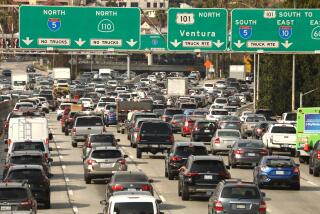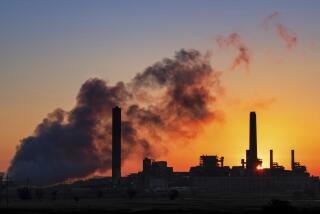Clean-Air Debate Pits Economics, Science
- Share via
CHICAGO — Within the confines of a hotel meeting room in downtown Chicago, all the arguments that come to bear in the nation’s debate over cleaning up its air could be heard on Tuesday.
Carl Le Gant is the mayor of Countryside, a small town southwest of Chicago. His wife is suffering from what he portrayed as pollution-aggravated emphysema.
“Take a pillow, put it up to your face as tight as you can and try breathing.” That, Le Gant said, is emphysema. And don’t blame smoking, he said; she gave it up 50 years ago when they were married.
David A. Sykuta, executive director of the Illinois Petroleum Council, issued a warning. The federal government, in its consideration of the tougher pollution standards that were the subject of Tuesday’s public hearing, is on the verge of a program that will “raise taxes, stifle economic growth and create a lifestyle police . . . mandating car-pooling, a ban on wood-burning stoves and snow blowers,” he declared.
Health vs. dollars: How much will the nation spend? Indeed, how much can it afford to spend? And must it give up its cars and boats to breathe clean air? How much pollution is too much? At the core sits this question: Should the reality offered by science or the one offered by economics determine how clean an environment the nation will set as its goal?
Air pollution is responsible for hastening the deaths of 64,000 people a year in the United States, according to the Environmental Protection Agency. In Chicago, 80% of the air pollution is blamed on the steel mills ringing the southwestern shore of Lake Michigan--not on the snow blowers and motorboats and old automobiles that draw such attention in the debate.
On Nov. 27, the agency came up with what is widely viewed as its greatest effort yet to reduce the number of premature deaths by improving air quality. The sharply strengthened air pollution standards that it proposed could lead to new restrictions on the amount of soot and smog that polluters--mostly factories and vehicles--would be allowed to emit each year. Unless changed, they become final at the end of June.
The standards do not themselves impose regulations on the amount of pollutants that may be sent into the air. Rather, they state the level of ozone and particulates that makes unhealthy conditions. Such standards then provide the basis for government regulation.
Ground-level ozone is a gas that contributes to smog. Particulates are the nearly invisible pieces of metal and the detritus of combustion that make up soot.
On Tuesday, those most affected by the proposal--among them industries, interest groups and individuals--had their say at a public hearing in Chicago and at similar sessions in Boston and Salt Lake City.
The meeting here produced nothing resembling a consensus among the 102 people signed up to testify. Rather, said Mary Nichols, assistant administrator of the EPA for air quality, the comments were intended to complement “a very extensive scientific” process that produced the proposed standards.
The hearing offered a compelling picture of the personal and economic dynamics at the heart of the issue.
The Damitz boys--8-year-old Kyle and 10-year-old Jeff--have severe asthma.
In a precise but unhurried little-boy voice, Kyle told Nichols, who was presiding at the hearing, what the illness means: “I hate going to the hospital. They poke tubes in you. I get shots. I can’t play outside. Why would we want to pollute the air? I don’t understand why people want to do that.”
But are the government’s standards the best way to deal with the problem?
No, said John McKnight, director of environmental compliance of the National Marine Manufacturers Assn., which represents the makers of pleasure boats and engines.
Cutting back emissions from such vessels, he said, would have “a devastating effect” on the recreational marine business. Industry after industry--oil companies, representatives of small business, energy utilities--echoed those concerns.
Times staff writer Marla Cone in Los Angeles contributed to this story.
More to Read
Sign up for Essential California
The most important California stories and recommendations in your inbox every morning.
You may occasionally receive promotional content from the Los Angeles Times.










